Servicios Personalizados
Articulo
Latin American applied research
versión On-line ISSN 1851-8796
Lat. Am. appl. res. vol.44 no.4 Bahía Blanca oct. 2014
Effects of heat source, chemical reaction, thermal diffusion and magnetic field on demixing of a binary fluid mixture flowing over a stretched surface
B.R. Sharma and K. Nath
Department of Mathematics, Dibrugarh University, Dibrugarh-786004, Assam, India E-mail: bishwaramsharma@yahoo.com, kabitanath56@gmail.com
Abstract— Effects of viscous dissipation, heat source, thermal diffusion and chemical reaction on demixing of a binary mixture of incompressible viscous electrically conducting fluids in two dimensional magnetohydrodynamic boundary layer flow on a vertical stretching surface are investigated. The momentum, energy and concentration equations are reduced to non-linear coupled ordinary differential equations by similarity transformations and are solved numerically by using MATLAB's built in solver bvp4c. These numerical results are exhibited graphically from which it has been found that the effects of various parameters are to separate the components of the binary mixture by collecting the lighter and rarer component near the plate and throwing the heavier one away from it.
Keywords— Heat and Mass Transfer; Binary Fluid Mixture; Thermal Diffusion and Chemical Reaction; Heat Source; Magnetic Field.
I. INTRODUCTION
Separation processes of an electrically conducting binary mixture of incompressible viscous fluids under the influence of magnetic field are considered to be of significant importance due to their applications in many engineering problems such as nuclear reactors and those dealing with liquid metals. A large amount of research work has been done in the field of chemical reaction, heat and mass transfer. There has been renewed interest in studying hydromagnetic flow and heat transfer of continuously stretched surfaces in the presence of a weak transverse magnetic field. This is because hydromagnetic flow and heat transfer have become more important industrially and in many branches of science and engineering.
A study has been carried out to obtain the non-linear MHD flow with heat and mass transfer characteristic of an incompressible viscous, electrically conducting and Boussinesq fluid on a vertical isothermal, cone surface with heat generation/ absorption by El-Kabier et al. (2007); Kandasamy and Devi (2004) studied effects of chemical reaction, heat and mass transfer on non-linear laminar boundary layer flow over a wedge with suction and injection. Takhar et al. (2000) investigated the flow and mass diffusion of chemical species with first order and higher order re-actions over a continuous stretching sheet with an ap-plied magnetic field.
A study on non-linear hydromagnetic flow, heat and mass transfer over an accelerating vertical surface with internal heat generation and diffusion effects is carried by Kandasamy and Periasamy (2005). Singh (2001) analyzed the MHD free convection and mass transfer flow with heat source and thermal diffusion. The paper deals with the study of free convection and mass transfer flow of an incompressible, viscous and electrically conducting fluid past a continuously moving infinite vertical plate in the presence of large suction and under the influence of uniform magnetic field considering heat source and thermal diffusion. A study on MHD free convective flow of an incompressible viscous dissipative fluid in an infinite vertical oscillating plate with constant heat flux has been carried by Kishan et al. (2006).
The problem of stretching surface with constant surface temperature was analyzed by Afzal (1993). The process involving the mass transfer effect has long been recognized as important principality in chemical processing equipment. Recently, the non linear MHD flow with heat and mass transfer characteristic of an incompressible, viscous, electrically conducting and Boussinesq fluid on a vertical stretching surface with chemical reaction and thermal stratification effects are studied by Kandasamy et al. (2005) and Kishan and Amrutha (2010).
Sharma and Singh (2008, 2009, 2010), Sharma and Nath (2012) and Sharma et al. (2011, 2012) studied the effect of magnetic field on demixing of a binary fluid mixture. Sharma and Singh (2004, 2007) studied the effect of temperature gradient on demixing of species in hydromagnetic flow of a binary mixture of incompressible viscous fluids between two parallel plates, first taking the plates horizontal and second by taking the plates vertical. They found that the effect of temperature gradient is to separate the components of the binary mixture and the magnetic field increases the effect of species demixing.
The present paper deals with two dimensional steady nonlinear MHD boundary layer flow of an in-compressible viscous electrically conducting binary mixture of fluids flowing over a vertical stretching surface in presence of uniform magnetic field by taking into account the viscous dissipation, heat source, chemical reaction and thermal diffusion with a motive to study the effects of various parameters on demixing of the binary fluid mixture.
II FORMULATION OF THE PROBLEM
Consider a two-dimensional steady nonlinear MHD boundary layer flow, heat and mass transfer of a binary fluid mixture of electrically conducting fluids flowing over a vertical stretching surface in presence of uniform weak magnetic field by taking into account the viscous dissipation with chemical reaction and thermal diffusion effects. The x-axis is taken parallel to the vertical surface and the y-axis is taken normal to it. A transverse weak magnetic field of strength B0 is applied parallel to y-axis. The fluid properties are assumed to be constant in a limited temperature range. The chemical reactions are taking place in the flow and the physical properties μ, ρ, D and the rate of chemical reaction k1 are constant throughout the fluid. It is assumed that the induced magnetic field, the external electric field and the electric field due to the polarization of charges are negligible. Under these assumptions, the governing boundary layer equations of momentum, energy and diffusion under Boussinesq approximation are
 | (1) |
 | (2) |
 | (3) |
 | (4) |
where u and v denote the velocity components in x, y- directions respectively, U is the potential flow velocity, ν is the kinematic viscosity, g is the acceleration due to gravity, β is the coefficient of thermal expansion, β* is the coefficient of concentration expansion, T is the temperature of the fluid mixture, T∞ is the free stream temperature, Tw is the surface temperature of the plate, C is the concentration of the species, Cw is the concentration of the species at the plate, C∞ is the concentration of the species far away from the wall, σ is the electrical conductivity of the medium, ρ is the density of the fluid mixture, cp is the specific heat at constant pressure, α is the thermal conductivity of the fluid mixture, Q is the heat generation coefficient, μ is the coefficient of viscosity, D is the molecular diffusion coefficient, ST is the Soret number and k1 is the chemical reaction coefficient.
The boundary conditions are
 | (5) |
where a is dimensional constant and n is a constant which is the thermal diffusion parameter and is such that 0≤n≤1, n being the thermal diffusion parameter is equal to m1/(1+ m1) of Nakayama and Koyama (1989), where m1 is constant. T0 is constant reference temperature say, T∞(0). The suffix w and ∞ denote surface and ambient conditions respectively.
Now we introduce similarity variables as follows:
 | (6) |
 | (7) |
The velocity components are given by:
 | (8) |
It can be easily verified that the continuity Eq. (1) is identically satisfied. Similarity solutions exist if we assume that U(x) = ax and introduce the non dimensional form of temperature and concentration as:
 |
The set of Eqs. (2)-(4) are coupled partial non-linear differential equations. Introducing the relation (6)-(8) into the Eqs- (2)-(4) we obtain the following non-linear coupled ordinary differential equations:
 | (9) |
 | (10) |
 | (11) |
where Gr=vgb (Tw-T∞)/U3 is the Grashof number, Re=Ux/v is the Reynolds number, Gc=vgβ* (Cw-C∞)/U3 is the modified Grashof number, M2=σB02/(ρa) is the magnetic parameter, Pr=μcp/α is the Prandtl number, S=Q/(ρacp) is the heat source parameter, Br=μU2/ (α(Tw-T∞)) is the Brinkman number, Sc=v/D is the Schimdt number, γ=vk1/U2 is the chemical reaction parameter and td=ST(Tw-T∞) is the thermal diffusion number.
The boundary conditions given by Eqs. (5), in light of Eqs. (6) to (8), become
 | (12) |
Since the solutions of the set of non-linear coupled ordinary differential equations (9)-(11) under the boundary conditions (12) cannot be obtained in a closed form therefore we have solved these equations numerically with MATLAB's built-in solver bvp4c.
III RESULTS AND DISCUSSION
In order to get a clear insight of the physical problem, numerical calculations have been carried out for various values of the parameters M, Gr, Gc , Re, S, γ, Sc and td, and these numerical results for concentration of the lighter component of the binary fluid mixture are plotted against η for various values of above mentioned parameters and are displayed in Figs. 1-8. It is observed from the figures that the concentration of the lighter component of the binary mixture is more at the plate and decreases exponentially as η increases from 0 to 2.
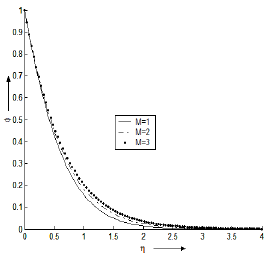
Figure 1. The graph of ø against η, Gr=1, Re=3, Gc=3, Pr=0.71, S=0.2, Br=2, Sc=0.62, γ=1 and td=0.001 for various values of M.
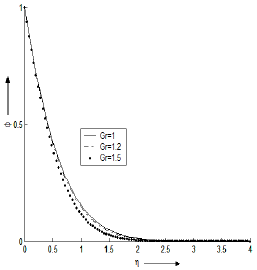
Figure 2. The graph of ø against η, M=1, Re=3, Gc=3, Pr=0.71, S=0.2, Br=2, Sc=0.62, γ=1 and td=0.001 for various values of Gr.
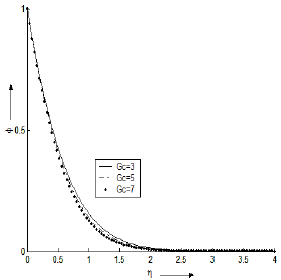
Figure 3. The graph of f against η, Gr=1, Re=3, M=1, Pr=0.71, S=0.2, Br=2, Sc=0.62, γ=1 and td=0.001 for various values of Gc.
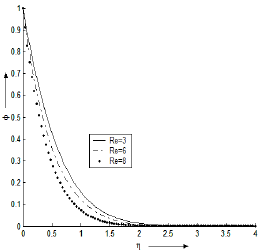
Figure 4. The graph of ø against η, M=1, Gr=1, Gc=3, Pr=0.71, S=0.2, Br=2, Sc=0.62, γ=1 and td=0.001 for various values of Re.
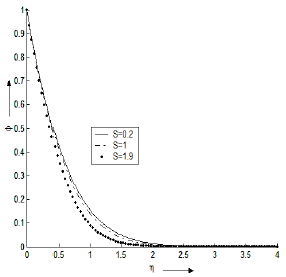
Figure 5. The graph of ø against η, Gr=1, Re=3, Gc=3, Pr=0.71, M=1, Br=2, Sc=0.62, γ=1 and td=0.001 for various values of S.
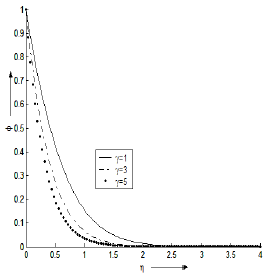
Figure 6. The graph of ø against η, M=1, Gr=1, Re=3, Gc=3, Pr=0.71, S=0.2, Br=2, Sc=0.62 and td=0.001 for various values of γ.
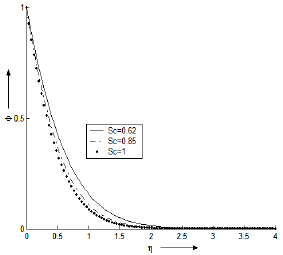
Figure 7. The graph of ø against η, M=1, Gr=1, Re=3, Gc=3, Pr=0.71, S=0.2, Br=2, γ=1 and td=0.001 for various values of Sc.
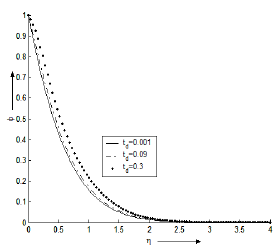
Figure 8. The graph of ø against η, M=1, Gr=1, Re=3, Gc=3, Pr=0.71, S=0.2, Br=2, Sc=0.62 and γ=1 for various values of td..
Figure 1 and 8 depict that the concentration of the lighter and rarer component of the binary mixture increases with increase in the values of the parameters M and td and from Figs. 2-7 reverse effect is observed with increase in the values of the parameters Gr, Gc, Re, S, γ and Sc.
Thus we conclude that the effects of all these parameters is to demix the binary mixture by collecting the rarer and lighter component of the binary fluid mixture near the plate and throwing the heavier component away from it. From the process of numerical computation, the local skin friction, the Nusselt number and the Sherwood number, which are respectively proportional to  . are also worked out and their numerical values are presented in a tabular form.
. are also worked out and their numerical values are presented in a tabular form.
Finally, the effects of the local skin friction, the Nusselt number and the Sherwood number are shown in Table 1. The behaviour of these parameters is self - evident from the Table 1 and hence any further discussion about them seems to be redundant.
Table 1: Numerical values of f ''(0), θ'(0) and ø'(0) for Pr=0.71 and Br=2.
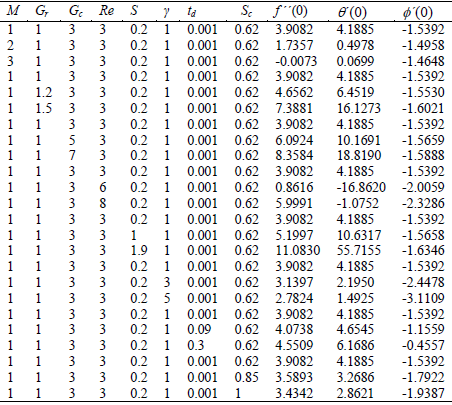
ACKNOWLEDGEMENT
This research work is funded by grants from the UGC, New Delhi, India (File No. 39-43/2010 (SR)) as a Major Research Project awarded to Dr. B. R. Sharma. Kabita Nath is associated with the project as a Project Fellow. The authors are grateful to UGC for providing financial support during the research work.
REFERENCE
1. Afzal, N., "Heat transfer from a stretching surface," Int. J. Heat Mass Transfer, 36, 1128-1131 (1993).
2. El-Kabeir, S.M.M, M. Modather and M. Abdou, "Chemical reaction, heat and mass transfer on MHD flow over a vertical isothermal cone surface in micropolar fluids with heat generation/absorption," Appl. Math. Sci., 1, 1663-1674 (2007).
3. Kandasamy, R. and S.P.A. Devi, "Effects of chemical reaction, heat and mass transfer on non linear laminar boundary layer flow over a wedge with suction or injection," Journal Comp. Appl. Mech., 5, 21-31 (2004).
4. Kandasamy, R. and K. Periasamy, "Non-linear hydromagnetic flow, heat and mass transfer over an accelerating vertical surface with internal heat generation and thermal stratification effects," Journal Comp. Appl. Mech., 1, 27-37 (2005).
5. Kandasmay, R., K. Periasamy and K.K.S. Prabhu, "Chemical reaction, heat and mass transfer on MHD flow over a vertical stretching surface with heat source and thermal stratification effects," Int. J. Heat and Mass Transfer, 48, 4557-4561 (2005).
6. Kishan, N. and P. Amrutha, "Effects of viscous dissipation on MHD flow with heat and mass transfer over a stretching surface with heat source, thermal stratification and chemical reaction," Journal of Naval Arch. and Marine Engg., 7, 11-18 (2010).
7. Kishan, N., Srihari and J.A. Rao, "MHD free convective flow of an incompressible viscous dissipative fluid in an infinite vertical oscillating plate with constant heat flux," Journal of Energy Heat and Mass Transfer, 28, 19-28 (2006).
8. Nakayama, A. and H. Koyama, "Similarity solutions for buoyancy-induced flows over a non-isothermal curved surface in a thermally stratified porous medium," Appl. Sci. Res., 46, 309-322 (1989).
9. Sharma, B.R. and K. Nath, "The effect of magnetic field on separation of binary mixture of viscous fluids by barodiffusion and thermal diffusion near a stagnation point- a numerical study," Int. Jour. Mathematical Archive., 3, 1118-1124 (2012).
10. Sharma, B.R. and R.N Singh, "Soret effect in generalized MHD Couette flow of a binary mixture," Bull. Cal. Math. Soc., 96, 367-374 (2004).
11. Sharma, B.R. and R.N Singh, "Soret effect due to natural convection between heated vertical plates in a horizontal small magnetic field," Ultra Science, 19, 97-106 (2007).
12. Sharma, B.R. and R.N. Singh, "Barodiffusion and thermal diffusion a binary fluid mixture confined between two parallel discs in presence of a small axial magnetic field," Latin American Applied Research, 38, 313-320 (2008).
13. Sharma, B.R. and R.N. Singh, "Thermal diffusion in a binary fluid mixture confined between two concentric circular cylinders in presence of radial magnetic field," J. Energy Heat Mass Transfer, 31, 27-38 (2009).
14. Sharma, B.R. and R.N. Singh, "Separation of species of a binary fluid mixture confined between two concentric rotating circular cylinders in presence of a strong radial magnetic field," Heat Mass Transfer, 46, 769-777 (2010).
15. Sharma, B.R., R.N Singh and R.Kr. Gogoi, "Effect of a Strong Transverse Magnetic Field on Separation of Species of a Binary Fluid Mixture in Generalized Couette Flow," Int. Journal of Applied Engineering Research, 6, 2223-2235 (2011).
16. Sharma, B.R., R.N Singh, R.Kr. Gogoi and K. Nath, "Separation of species of a binary fluid mixture confined in a channel in presence of a strong transverse magnetic field," Hem. Ind., 66, 171-180 (2012).
17. Singh, A.K., "MHD free convection and mass transfer flow with heat source and thermal diffusion," J. Energy Heat Mass Transfer, 23, 227-249 (2001).
18. Takhar, H.S, A.J Chamkha and G. Nath, "Flow and mass transfer on a stretching sheet with magnetic field and chemically reactive species," Int. J. Eng. Sce., 38, 1303-1314 (2000).
Received: August 22, 2013
Sent to Subject Editor: February 5, 2014
Accepted: March 25, 2014
Recommended by Subject Editor: Walter Ambrosini












